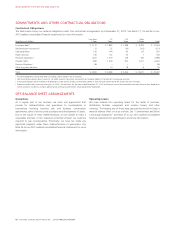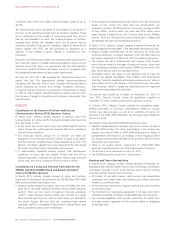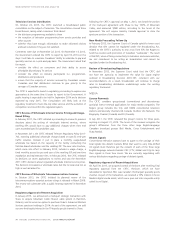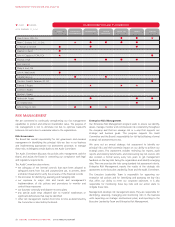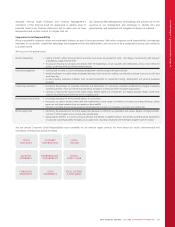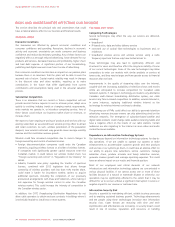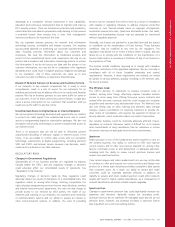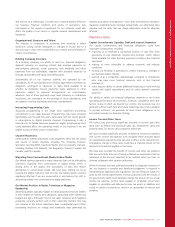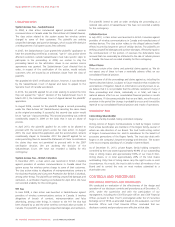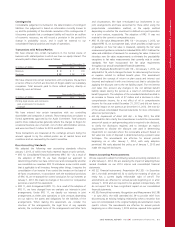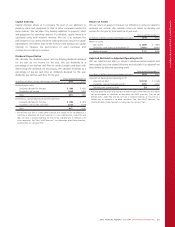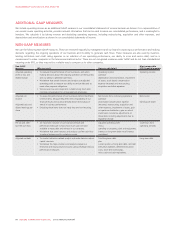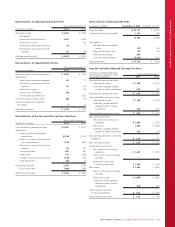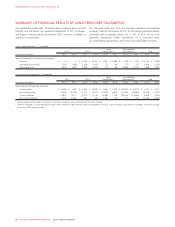Rogers 2013 Annual Report Download - page 80
Download and view the complete annual report
Please find page 80 of the 2013 Rogers annual report below. You can navigate through the pages in the report by either clicking on the pages listed below, or by using the keyword search tool below to find specific information within the annual report.MANAGEMENT’S DISCUSSION AND ANALYSIS
Higher Handset Subsidies
Our wireless business model is based substantially on subsidizing the
cost of subscriber handsets, similar to other North American wireless
carriers. This attracts customers and in exchange they commit to a term
with us. We also commit to a minimum subsidy with the supplier of
certain smartphone devices.
National Wireless Tower Policy
The policy affects all parties that plan to install or modify an antenna
system, including PCS, cellular and broadcasting service providers. The
policy requires, among other things, that antenna proponents consider
using existing antenna structures before proposing new structures and
those owners of existing systems respond to requests to share antenna
systems. Antenna proponents must follow a defined process for
notifying the public and addressing local requirements and concerns.
Certain types of antenna installations, however, are excluded from the
consultation requirements with local authorities and the public.
Radio Frequency Emissions
From time to time the media and other reports have highlighted alleged
links between radio frequency emissions from wireless handsets and
various health concerns, including cancer, and interference with various
medical devices, including hearing aids and pacemakers. This may
discourage the use of wireless handsets or expose us to potential
litigation even though there are no definitive reports or studies stating
that these health issues are directly attributable to radio frequency
emissions.
It is also possible that future regulatory actions may result in more
restrictive standards on radio frequency emissions from low-powered
devices like wireless handsets. We cannot predict the nature or extent
of any restrictions.
Obtaining Access to Support Structures and Municipal Rights
of Way
We must have access to support structures and municipal rights of way
for our cable facilities. We can apply to the CRTC to obtain a right of
access under the Telecommunications Act in areas where we cannot
secure access to municipal rights of way. Failure to obtain access could
increase Cable costs and adversely affect our business.
The Supreme Court of Canada ruled in 2003, however, that the CRTC
does not have the jurisdiction to establish the terms and conditions of
accessing the poles of hydroelectric companies. As a result, we obtained
access under orders from the Ontario Energy Board and the New
Brunswick Public Utilities Board.
Dependence on Facilities and Services of ILECs
Business telephony operations that are outside our cable territory highly
depend on the availability of facilities and services acquired from
incumbent telecom operators, according to CRTC rules. Changes to
these rules could significantly affect the cost of operating these
businesses.
Copyright Tariffs
Pressures on copyright tariffs continue to affect our services. Any
increase in fees could negatively affect our results of operations.
BUSINESS RISKS
Revenue Expectations from New and Advanced Services
We expect that a substantial portion of our future revenue growth may
come from new and advanced services, and we continue to invest
significant capital resources to develop our networks so we can offer
these services. It is possible, however, that there may not be sufficient
consumer demand, or that we may not anticipate or satisfy demand for
certain products and services, or be able to offer or market these new
products and services successfully to subscribers. If we do not attract
subscribers to new products and services profitably or keep pace with
changing consumer preferences, we could experience slower revenue
growth and increased churn. This could have a materially adverse effect
on our business, results of operations and financial condition.
Acquisitions, Divestitures or Investments
Acquiring complementary businesses and technologies, developing
strategic alliances and divesting portions of our business are often
required to optimally execute our business strategy.
Services, technologies, key personnel or businesses of companies we
acquire may not be effectively assimilated into our business or service
offerings, or our alliances may not be successful. We also may not be
able to successfully complete any divestitures on satisfactory terms, if at
all. Divestitures may reduce our total revenues and net income by more
than offset by the sales price.
Inventory Obsolescence
Our inventory balance mainly consists of wireless handset devices,
which generally have relatively short product life cycles due to frequent
wireless handset introductions. If we cannot effectively manage
inventory levels based on product demand, this may increase the risk of
inventory obsolescence.
Complexity of Our Business
Our businesses, technologies, processes and systems are operationally
complex and increasingly interconnected. If we do not execute properly,
or if manmade or natural disasters impact them, customers may have a
negative experience, resulting in increased churn and lower revenue.
Reliance on Third Party Service Providers
We have outsourcing arrangements with third parties to provide certain
essential components of our business operations to our employees and
customers, including payroll, certain facilities or property management
functions, call centre support, certain installation and service
technicians, certain information technology functions, and invoice
printing. Interruptions in these services can adversely affect our ability to
service our customers.
Dependence on Certain Key Infrastructure and Handset
Vendors
Our wireless business has relationships with a relatively small number of
essential network infrastructure and handset vendors. We do not have
operational or financial control over them, and only have limited
influence on how they conduct their business with us.
If one of our network infrastructure suppliers fails, it could delay adding
network capacity or new capabilities and services across the business.
Handsets and network infrastructure suppliers can extend delivery
times, raise prices and limit supply due to their own shortages and
business requirements, among other things. If these suppliers do not
develop handsets that satisfy customer demands, or deliver products
76 ROGERS COMMUNICATIONS INC. 2013 ANNUAL REPORT


